Page1
Page2
Page3
Page4
Page5
Page6
Page7
above
is an Agni-Anna stage of Varuņa which is alternately written as ‘Agni
with quadruped
or with two
vertical straight lines’. This may be compared with another inscription of
Harappa
where one vertical straight line (i. e. first form of A) flanked by a double
is succeeded by two vertical straight lines and then both equated with An-Anna (
) compound
of gross A ( v ). This shows
that the first form of A ( vertical straight line with double b is same as Agni
with quadruped b, each set signifying An-Anna compound equated with the
symbols of two vertical straight lines which only seem to indicate the double
initial A (v ) of an An and Anna. Thus in the remaining set of the letter A
(one straight line) flanked by b
signifying the An-Anna compound, v stands for An
and b for Ann. In the same way Agni represents An (vu) and b accompanying it
indicates Anna (vUUk).
This An-Anna or v&b or vfXu b compound is Varuņa but not in its role of the enjoyer
(Bhokta). In other words, it is only Varuņa the bhokta (enjoyer) that is
associated with noose or snare and can be equated with the Agni forming a
trinity with Avara, Indra and Soma, and not the higher Varuņa equated with compound
which seems to be equated with Parā Indra absorbing Agni as well as Soma.
IDENTITY WITH VEDIC CULTURE
In
this way, the examples may be multiplied, but it is sufficient to prove the
identity of
Indus
culture with the Vedic. Scholars have often questioned this identity on the
ground that the horse and the cow, so popular with the Vedic people are
conspicuous by their absence in
Indus
Valley
relics. In the same breath, they speak of the non-Aryan deities like Shiva and
the mother goddess in the pantheon of the
Indus
Valley
, and non-availability of the sacrificial cult in religion of the
Indus
people. It is, therefore, necessary to state briefly my own views in this
respect.
SACRIFICCIAL ALTARS
This
Vedic origin of the Indus Culture as seen in the symbolism of Indus alphabet is
further confirmed by the discovery of sacrificial altars, on both the mounds (in
the Harappa levels) at Kalibanga. Not far from the wells and terraces already
mentioned above, there is a big mud-brick platform having one main altar (called
Mahāvedi in Vedic rituals) with a small pit for holding jar of Praņitā
waters in a Vedic sacrifice. Beside this Mahāvedi , there is a row of six
small pits all of which, like the main altar, retain even now the evidence to
show that they were once the seats of fire. This is in contrast with the small
pit for water jar having no trace of fire-burning at all. The six small pits are
decidedly the seats of the six Vedic fires, namely
ñkwRlTkAùä
CkkcrU’Zkä RldkOkk†CTkä ¢kc^kTkmZkä bkXZk
and ¢k^kbkQZk all of them
having a role to play in the Srauta sacrifices. (see P. V. Kane’s ‘History
of Dharmashastra’ pp. 992-998).
SARVATOMUKHA AGNI
The
six fires may be compared with the six heads of different animals joined to a
heart-like thing and together presenting a composite picture found in two seals
of Mohenjodaro. I have elsewhere identified this symbol with the Sarvatomukha
Agni
(the fire with faces on all directions) of the Brahamanas, and now, after seeing
the Kalibanga set of altars described above, I vendure to suggest that the
concept of Sarvatomukha Agni, as also its counterpart on Indus seals is only a
composite symbol representing the six fires of the Vedic sacrifice referred to
above.
THE FIRE OF VŖTRA-SACRIFICE
One
of the inscriptions of
Kalibanga published by the Archaeological Survey of
India
would read, according to my decipherment, as Vŗtra-Jasna-Agni meaning
‘the fire of Vŗtra sacrifice’. Bearing in mind that Vŗtra is a
demon in Vedic literature, this fire may be compared with our annual Holi Fire
which is believed to symbolize the burning of Holika, sister of the demon
Hiranyakasyapa. the same again maybe compared with the annual burning of Ravana,
the great demon of the Ramayana. It is to be remembered, in this connection,
that the concept of Vŗtra includes all that is evil and hostile to man
including the mental and physical ailments. That this is so is proved not only
by Vedic literature and various inscriptions of mohenjodaro and
Harappa
but also by those found at kalibanga. Thus, on one of the kalibanga potsherds we
can read indicating
the inclusion of mental evils in the concept of Vŗtra. In the same way, the
word Vŗtrasā (Vŗtrahā in Mohenjodaro) meaning the ‘Killer
of Vŗtras’ inscribed on storage jars of food grains seems to suggest the
insects eating the food grains as the Vŗtras whom the inscription ‘the
Killer of Vŗtra’ seems to be intended to ward off
THE
SACRIFICE OF THE DIVINE FIRE
The
fire of Vŗtra sacrifice may be compared with other forms of fire mentioned
in various inscriptions on Indus seals of Unicorn that are being published in
the next issue of Swaha. To mention a few, there we come across with the fire of
Heaven, the Prāna-Agni, the fire of mind, the fire of Indra, the eternal
Agni, Agni the eater and the like. There is also a concept of the Agni as the
part of Savitŗ (the sun-god) or the Energy. As for example,
one of the two stick-like objects each having a flame bear the inscription
‘Savitrānsha’ meaning a portion of Savitŗ, and with the words ‘Śava-ansha’
seems to symbolize a portion of Śavas, the energy of the Vedic Indra. Had
there been no inscription on these objects with flame like tops, they could very
well be mistaken for the phallus emblems.
SHIVA-LINGA
I
purposely emphasize this point, as it has a direct bearing with the
Indus
Valley
concept of Shiva Lingam which has been proclaimed by scholars as a phallus
sign, in spite of the fact that tradition regards the Shiva-linga as Jyotirlinga
(the emblem of light). As I have explained in detail in my ‘Bharatiya
Smajashastra’, Shiva-linga is only an imitation of the flame of fire rising
from the sacrificial fire, whereas the sacrificial fire is the symbol of the
inner light within human body which is represented by the sacrificial altar.
This accounts for the use of Vedic Agni-mantras in the worship of Shiva. It is,
therefore, absolutely wrong to consider Shiva-linga as phallus. Thus, the
numerous lingas found in the
Indus
Valley
must be regarded as the small symbols of the ‘divine flame’ within us.
ŚIŚNA
AND LINGA
In
this connection a reference may be made to the word ‘Śiśna-deva’
occurring twice in the Ŗgveda. On the strength of this word, scholars are
apt to conclude that the Indus culture was a non-Vedic culture, because in their
opinion the ‘Śiśna -deva’ condemned by the Ŗgveda are no
other than the phallus worshiping
Indus
Valley
people. They seem to overlook the fact that the Śiśna -deva,
according to tradition, means a debauch and that the Śiśna is
not the exact synonym of the linga. For example, in grammar we have Śiśna
-linga, Pum-linga and Klīva-linga where the word linga cannot be
substituted by the word Śiśna. The word linga in Sanskrit originally
meant ‘a characteristic mark’ by which a thing or a person could be
identified. Thus, the Varņi-lingi in ‘Kumāra-sambhava’ means one
having the characteristics of a Bramhachari. In the same way, the Vaiśeśika
and Nyāya Sutra, speak of the various psychic functions as Lingas of the Ãtman.
Therefore, while the word may in a derivative
and secondary sense, signify Śiśna, vice-versa is not true, and the
word Śiśna -deva cannot be equated with the worshiper of Shivalinga
which, as stated above, represents the divine fire within us all.
This
however, does not mean that sex was tabooed in
Indus
Valley
or Vedic tradition. In Upaniśads and Brāhmanas where several symbols
of
Indus
Valley
have been found, there are several references
to sex life. For example, Śatapatha Brahmana identifies the mūsala and
Ulūkhala used in sacrificial ritual with Śiśna and
yoni
respectively. Already in the Atharva-Veda, the great red śēpa of the
Bramhachari (the creator) as the instrument for sprinkling. His
retas (seed) on the mountain is said to have descended on the earth crying and
roaring (from Heaven) and may be taken to serve as a prototype of the huge
Shiva-linga of the Purānas, the
two ends of which are not known even to the great gods. Nonetheless, it will be
futile to see in this metaphor any trace of phallus worship. Even when the
Śatapatha Brāhmana uses the word Śiśna, it is used with the
epithet śochişkeśa (having flames as its hair) employed obviously
for fire in the Ŗgveda
and can clearly be taken to condemn debauchery
similar to that implied in the term Śiśna -deva mentioned above.
In
the light of the above fact, there is no justification is seeing phallus worship
in Shaivism and regard the Indus culture as Non-Vedic on that account only.
PURA, THE WALLED CITY
Equally
erroneous is the view that the
Indus
civilization of walled cities is non-Vedic. This theory is based on the wrong
notion encouraged by the initial discovery of the walled cities like Mohenjodaro
and
Harappa
. It was thought that these were the Puras which are reported to have been
shattered by Purandara (the shatterer of Puras),
Indra of Vedic literature. But, in this context, it must be remembered that
Vedic civilization was not entirely rural and something hostile to urban
civilization of the
Indus
Valley
type. Ŗgveda makes several
references to Pauras
(lit, the residents of Pura or city) and Indra
himself is Paura. Several gods
are associated with a Pura and the Atharva-Veda,
in a beautiful metaphor, describes human body as the city of
Ayodhya
belonging to gods, with eight circles and nine doors. In fact, some such idea
seems to be responsible for conceiving Indra, the human soul, as Purandar,
because it is in this Pura that he has bored out extrovert holes
and it is in this sense that he is said to have made
openings for providing abode to various senses and an entrance for himself.
Therefore,
Puras or walled cities of the
Indus
civilization, far from suggesting any non-Vedic source for themselves, provide
a clear evidence for their Vedic origin. The hundred citadels of Śamvara
smashed by Indra or the hundred puras
encircling the Soma (or shyena) therefore, would only mean the numerous layers
of ‘obscuration’ that hides the Divine bliss called Śam or Soma in the
Vedas. In
Indus
culture also, this Divine bliss is
the chief goal of human life, as will be clear from the following inscription
from Mohenjodaro :
'ka eka u jRu/kk( u vUuon~cq/kk
“let
there be bliss for me, and not the giver of jewels; for the wise people do not
hanker after enjoyment.”
THE MYSTERIOUS UNICORN
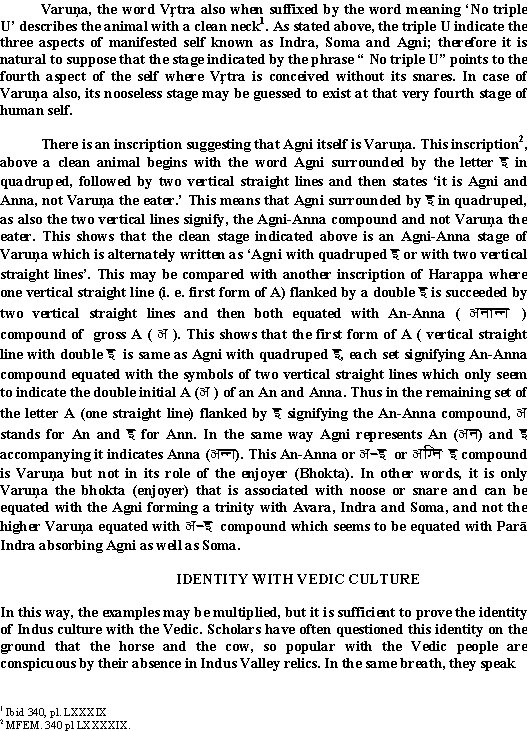
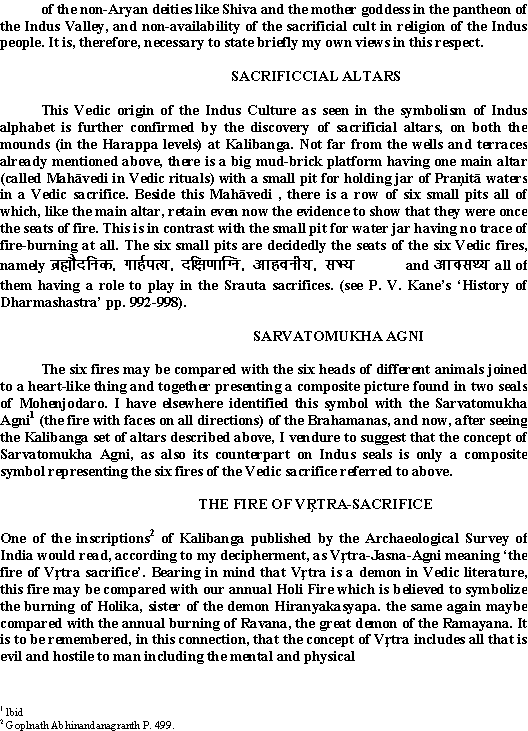
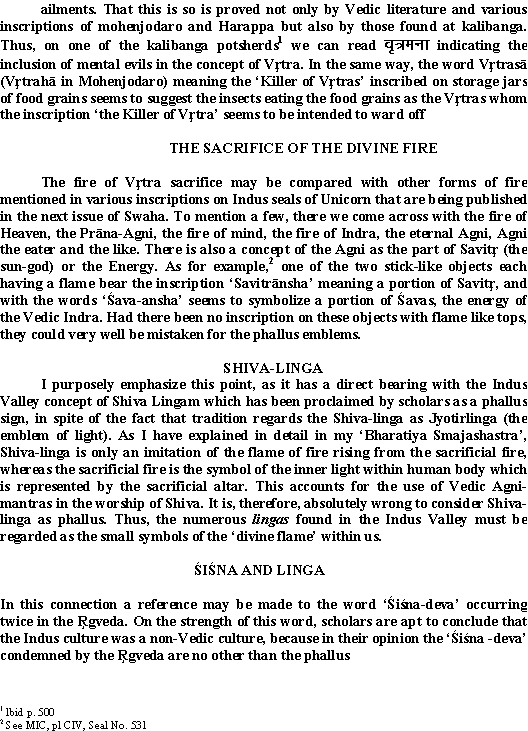
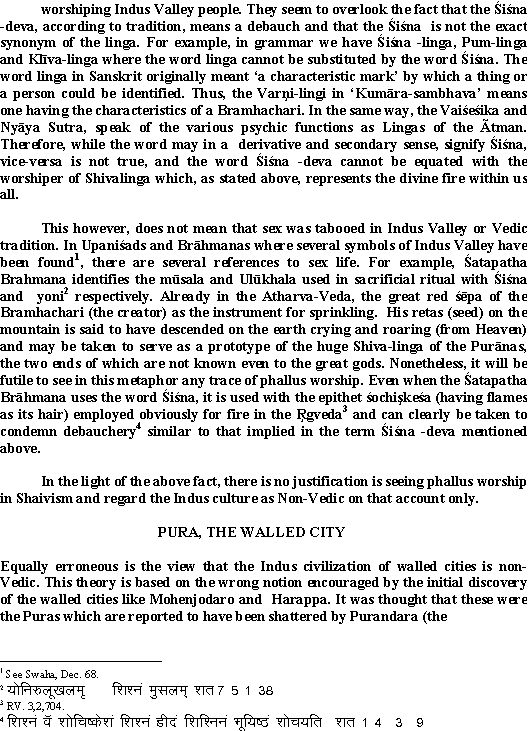
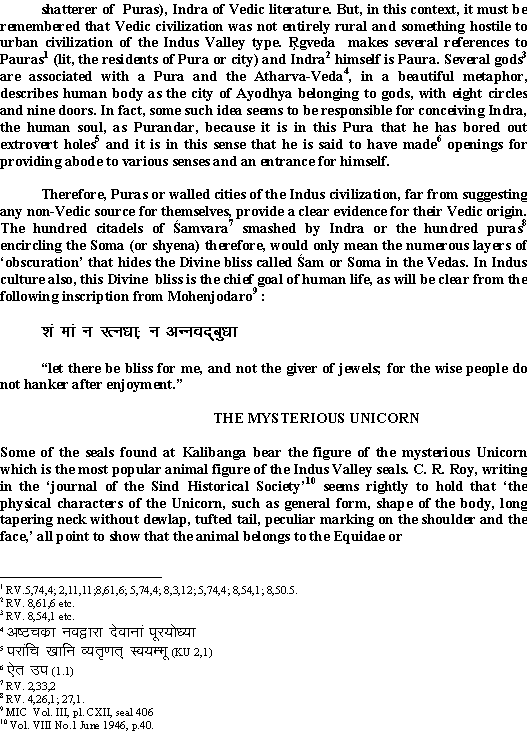
Page1
Page2
Page3
Page4
Page5
Page6
Page7
![]()